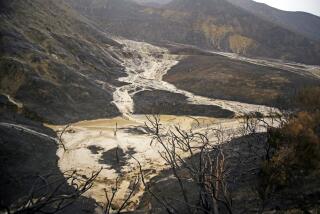Sediment in Reservoirs Poses a Gritty Problem
How do you get rid of more than 25 million cubic yards of sediment?
That’s the dilemma confronting the Los Angeles County Department of Public Works. Vast quantities of the stuff, the product of decades of crumbling and drifting in the San Gabriel Mountains, have accumulated in three reservoirs above Azusa. The sediment takes up space in Morris, San Gabriel and Cogswell reservoirs, limiting the reservoirs’ capacity to control floods and threatening to gunk up valves in flood control dams, county officials say.
The Department of Public Works this month proposed a controversial pilot program to sluice a quantity of sediment out of Morris Reservoir, about 4 miles north of Azusa. By opening Morris Dam and flushing the sediment downstream, county officials said, they could cleanse the reservoir at a low cost with little impact on the environment.
But the state Department of Fish and Game last week sued to delay the program, saying it would kill fish and wildlife in the lower reaches of San Gabriel Canyon. At the same time, a conservation group has charged that the county has gone back on longstanding agreements to consult with other parties before embarking on new programs.
Program Dropped for Now
In the face of the opposition, the county has abandoned the sluicing program until next year. While county officials have refused to discuss the program since the state initiated its lawsuit, the draining of Morris Reservoir, begun two weeks ago, has been stopped. Water from the San Gabriel Reservoir to the north is now refilling Morris Reservoir.
Paul Yoshinaga, an attorney with the office of the county counsel, said the refilling of Morris Reservoir was a step in preparing San Gabriel Reservoir for possible winter rain storms.
Sluicing could have dire environmental effects, says the state Department of Fish and Game. Gritty sediment in the stream bed of the San Gabriel River would not only wipe out bass and Western pond turtles, said Bruce Eliason, environmental services supervisor for the state agency. It would also threaten a rare “riparian,” or riverside, habitat used by such endangered birds as the least Bell’s vireo and the yellow-breasted chat as a summer habitat, he said.
“It’s a rapidly declining habitat type in Southern California,” said Eliason of the tree-lined stream bed, which meanders away from Morris Dam toward Azusa.
Experts have been sweating over the problem of sediment removal since the reservoirs were built more than 50 years ago. They have considered emptying the reservoirs, moving in heavy equipment and trucking the stuff out. But the reservoirs all sit in rocky, treacherously uneven terrain. “It’s questionable whether you could even do it safely,” says Garvin Pederson, assistant division engineer for the county agency.
Cost of Removal
At the least, county officials say, the bill for trucking the sediment would run to hundreds of millions of dollars. The county now pays between $8 and $10 a cubic yard to remove debris and sediment from debris control basins.
The low-cost alternative is sluicing, opening the dams and flushing the sediment downstream all the way to Santa Fe Flood Control Basin in Irwindale, from which commercial contractors could haul it away as construction fill, said county officials.
In preparation for the pilot program, a contractor had removed most of the smallmouth and largemouth bass in Morris Reservoir, storing them in Pyramid Lake and other reservoirs, and the draining of the reservoir had begun two weeks ago.
The next step would have been to release about 7,000 acre-feet of water--enough water to cover 7,000 acres with a foot of water--into the newly emptied Morris Reservoir over a period of 10 weeks. The idea was that the flow would carry as much as 1 million cubic yards of sediment into the stream bed.
The county prepared a “negative declaration,” contending that there would be no negative environmental impact from the program. But the state has demanded a detailed environmental impact report.
‘County Is Concerned’
“The county is certainly concerned about the environment,” said Yoshinaga. “We would never intentionally destroy endangered species or rare habitats. We want to proceed with those things in mind.”
But Jim Edmondson, Southern California manager for California Trout Inc., a nonprofit statewide group dedicated to the preservation of wild trout, says that the county has gone back on agreements to act only in concert with other interests.
A 4-party group, including Edmondson’s organization, the county Public Works Department, state Fish and Game Department and the U.S. Forest Service, has been meeting regularly on matters related to San Gabriel Canyon for more than 2 years.
The process was initiated after the county accidentally released 200,000 cubic yards of sediment from Cogswell Reservoir into the west fork of the San Gabriel River in 1981, then released a torrent of water while testing valves at Cogswell Dam in 1987. Both incidents destroyed wild trout in the stream, killing them with grit and sweeping away their spawning beds.
Though no formal agreement has been reached, said Edmondson, the parties had established a spirit of cooperation. “We were actually on the threshold of signing a document, making the stream as good as it could be without jeopardizing the community’s health and safety because of flood control problems,” Edmondson said. “Then this new fire breaks out.”
The program has been suspended, but the county still faces the problem of potentially clogged reservoirs, said Yoshinaga. Morris Dam alone is estimated to contain 15 million cubic yards of sediment, or about 30% of its capacity, he said.
More to Read
Sign up for Essential California
The most important California stories and recommendations in your inbox every morning.
You may occasionally receive promotional content from the Los Angeles Times.









